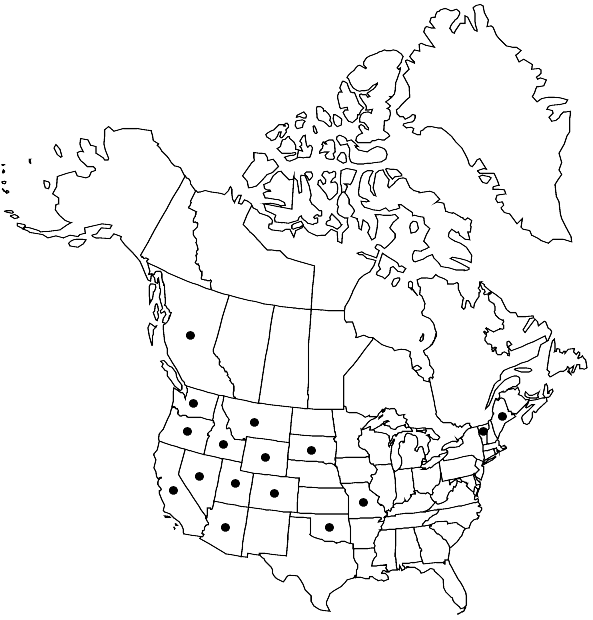Grimmia trichophylla
Fl. Edin., 235. 1824,.
Plants in dense to loose patches, yellowish green to dark green. Stems 2–4 cm, central strand present. Leaves loosely appressed, slightly twisted when dry, erecto-patent when moist, lanceolate to oblong-lanceolate, tapering to acute apex, 2–3.5 × 0.3–0.4 mm, usually sharply keeled, margins recurved on one or both sides, plane to erect distally, awns variable, short to long, smooth to denticulate, not conspicuously flattened at base, costa firm, projecting on abaxial side; basal juxtacostal laminal cells long-rectangular (rarely short-rectangular), ± nodulose, thick-walled; basal marginal laminal cells short- to long-rectangular, with thickened transverse walls; medial laminal cells quadrate to short-rectangular, slightly sinuose, thick-walled; distal laminal cells 1-stratose, occasionally with 2-stratose ridges. Gemmae clusters occasionally present in distal leaf axils. Sexual condition dioicous. Seta arcuate, 2–4 mm. Capsule occasionally present, exserted, oblong-ovoid, yellowish green to stramineous, striate when dry, exothecial cells thin-walled, annulus present, operculum rostrate, peristome teeth yellowish, papillose, deeply split and perforated. Calyptra mitrate.
Habitat: Dry, acidic rock
Elevation: moderate to high elevations (200-2000 m)
Distribution

B.C., Ariz., Calif., Colo., Idaho, Maine, Mo., Mont., Nev., Okla., Oreg., S.Dak., Utah, Vt., Wash., Wyo., Mexico, Eurasia, Pacific Islands (Hawaii), Australia.
Discussion
In North America, Grimmia trichophylla is principally a lowland species, occurring in the mountains up to about 1000 m., rarely higher. In the Southern Hemisphere, it may be found up to 4000 m. In New Zealand, the species is common, and in contrast to G. trichophylla in North America, frequently bears capsules. The New Zealand plants are usually smaller than American specimens, and the leaves are frequently contorted. The nearly cosmopolitan G. trichophylla has many phenotypes, and numerous subspecies and varieties have been described. In damp and shaded habitats, the awns may be short, just as in dry unfavorable habitats at high altitudes, where stunted specimens may occur with small, short leaves and reduced awns, or even with muticous leaves. Grimmia trichophylla has frequently been confused with related species such as 36. G. muehlenbeckii and 34. G. lisae (see discussions thereunder for identification details). Robust forms of G. trichophylla have been mistaken for G. austrofunalis (H. C. Greven 1997, 2003), which does not occur in North America. Although some of those plants have leaves of equal length along the stem, characteristic of G. austrofunalis, they also have both leaf margins recurved, and the medial and outer basal laminal cells are longer and more robust than in that species.
Selected References
None.